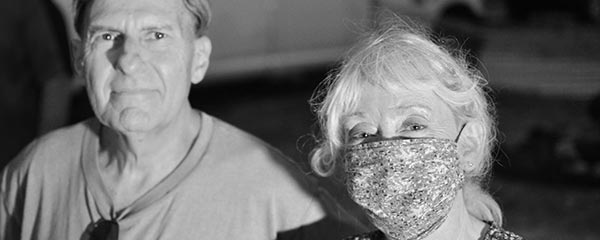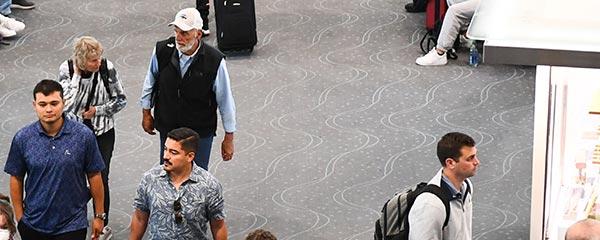Epidemiologists have firmly established that the probabilities of getting severe symptoms and dying from the coronavirus are positively correlated with age. This age relationship has a number of causes, including that older people are more susceptible to respiratory issues; have decreased immunity in general; are more likely to have underlying chronic diseases that make them more susceptible to severe consequences of the virus; and are in many instances living in close-quartered retirement and nursing homes.
We can assume that older people are aware of this relationship, although I haven't seen survey research that directly assesses people's knowledge of the relationship between age and susceptibility to the virus.
Given this assumption, we would logically conclude that older Americans would be the most likely to worry about getting the virus, most likely to socially isolate themselves and most likely to express trepidation about reduced social distancing. But the data don't confirm these hypotheses. I've been looking at the attitudes and self-reports of behavior for Americans 65 and older, and find that in most instances, this group is indistinguishable in their attitudes and behaviors from those who are younger.
I'm basing this analysis on a large sample of over 12,000 individuals in Gallup's panel interviewed between May 4 and May 24. I divided the sample into three groups by age: 18-64, 65-74, and 75-90, although for sample-size reasons, in some instances I collapse the last two into those 65 and older.
Worry About Getting the Virus Doesn't Differ by Age
The first measure of interest is worry or concern about getting the virus, a core question in Gallup's panel interviewing. Here we find that 49% of those 65-74 and 50% of those 75-90 are very or somewhat worried, compared with 52% of those 18-64. In other words, no significant difference by age.
| Very/Somewhat worried | Not very/Not at all worried | ||||||||||||||||||||||||||||||||||||||||||||||||||||||||||||||||||||||||||||||||||||||||||||||||||
|---|---|---|---|---|---|---|---|---|---|---|---|---|---|---|---|---|---|---|---|---|---|---|---|---|---|---|---|---|---|---|---|---|---|---|---|---|---|---|---|---|---|---|---|---|---|---|---|---|---|---|---|---|---|---|---|---|---|---|---|---|---|---|---|---|---|---|---|---|---|---|---|---|---|---|---|---|---|---|---|---|---|---|---|---|---|---|---|---|---|---|---|---|---|---|---|---|---|---|---|
| % | % | ||||||||||||||||||||||||||||||||||||||||||||||||||||||||||||||||||||||||||||||||||||||||||||||||||
| 18-64 years old | 52 | 48 | |||||||||||||||||||||||||||||||||||||||||||||||||||||||||||||||||||||||||||||||||||||||||||||||||
| 65-74 years old | 49 | 51 | |||||||||||||||||||||||||||||||||||||||||||||||||||||||||||||||||||||||||||||||||||||||||||||||||
| 75-90 years old | 50 | 50 | |||||||||||||||||||||||||||||||||||||||||||||||||||||||||||||||||||||||||||||||||||||||||||||||||
| Gallup Panel, May 4-24, 2020 | |||||||||||||||||||||||||||||||||||||||||||||||||||||||||||||||||||||||||||||||||||||||||||||||||||
Logic based on the virus' real-world impact would lead to the assumption that older people should be more worried about getting the virus. Why aren't they?
One explanation could involve social isolation. If older Americans are more likely to be confined to their dwelling units and less likely to go out, their lower level of worry could be because they believe they are not in a position to catch the virus.
But our data on social isolation and social distancing don't strongly support the hypothesis that older people are more homebound. Gallup's data show that 17% of Americans under age 65 say they are completely isolated, with another 37% saying they are mostly isolated. Older Americans' reports are not significantly different, with 19% of those 65-74 and 16% of those 75-90 saying they are completely isolated, and 41% and 40%, respectively, mostly isolated.
| 18-64 | 65-74 | 75-90 | |||||||||||||||||||||||||||||||||||||||||||||||||||||||||||||||||||||||||||||||||||||||||||||||||
|---|---|---|---|---|---|---|---|---|---|---|---|---|---|---|---|---|---|---|---|---|---|---|---|---|---|---|---|---|---|---|---|---|---|---|---|---|---|---|---|---|---|---|---|---|---|---|---|---|---|---|---|---|---|---|---|---|---|---|---|---|---|---|---|---|---|---|---|---|---|---|---|---|---|---|---|---|---|---|---|---|---|---|---|---|---|---|---|---|---|---|---|---|---|---|---|---|---|---|---|
| % | % | % | |||||||||||||||||||||||||||||||||||||||||||||||||||||||||||||||||||||||||||||||||||||||||||||||||
| Completely isolated yourself, having no contact with people outside your household | 17 | 19 | 16 | ||||||||||||||||||||||||||||||||||||||||||||||||||||||||||||||||||||||||||||||||||||||||||||||||
| Mostly isolated yourself, having very little contact with people outside your household | 37 | 41 | 40 | ||||||||||||||||||||||||||||||||||||||||||||||||||||||||||||||||||||||||||||||||||||||||||||||||
| Partially isolated yourself, having some contact with people outside your household | 23 | 24 | 33 | ||||||||||||||||||||||||||||||||||||||||||||||||||||||||||||||||||||||||||||||||||||||||||||||||
| Isolated yourself a little, still having a fair amount of contact with people outside your household | 14 | 10 | 8 | ||||||||||||||||||||||||||||||||||||||||||||||||||||||||||||||||||||||||||||||||||||||||||||||||
| Did not make any attempt to isolate yourself from people outside your household | 9 | 7 | 3 | ||||||||||||||||||||||||||||||||||||||||||||||||||||||||||||||||||||||||||||||||||||||||||||||||
| Gallup Panel, May 4-24, 2020 | |||||||||||||||||||||||||||||||||||||||||||||||||||||||||||||||||||||||||||||||||||||||||||||||||||
A separate question assessing self-reports of social distancing show some differences. Here we find that 65+ adults are about 12 percentage points more likely than those under age 65 to say they are "always" practicing social distancing, but the two groups are more equal when we look at the combined categories of those who report always and "very often" social distancing.
Older Americans are actually slightly more likely than those under age 65 to say they have been out to the grocery store in the previous 24 hours. Older Americans are also more likely to say they have visited a pharmacy and a doctor's office, hospital or treatment center, no doubt reflecting the higher probability of having medical conditions and prescriptions as age increases.
There is a big difference by age in leaving home to go to work, as we would expect. Older Americans are much less likely to be employed than younger Americans (only 15% of those 65 and older are employed either full or part time in our panel data, compared with 70% of those 18-64). There is a lot of remote working today, but 37% of those who are under age 65 have left their home to go to work within the 24 hours before they were interviewed, compared with 13% of those 65-74 and only 2% of those 75-90.
All in all, older Americans' worries about getting the virus may not be as high as expected because they are less likely to be working and are more likely to perceive themselves to be always practicing social distancing. But the data on self-reports of contact with other people and the frequency with which older and younger people get out to the store, pharmacy and doctor's offices don't confirm that hypothesis.
Partisanship Much More Powerful Than Age
There are often confounding influences at work when we look at the relationship between a demographic characteristic and another variable. Most demographic characteristics are associated with other characteristics, and sometimes those relationships help explain what's behind an initial finding.
In the current situation, we know that politics has an inordinately large role in determining virus-related attitudes and behavior, and that political identity is age-related.
Older Americans are substantially more likely to identify as Republicans than those under age 65. Republicans are much less worried than Democrats about the virus and less likely than others to socially isolate themselves. This could mean that the lack of higher levels of worry on average among older Americans is caused by their greater likelihood to be Republican.
The data, however, show that older Democrats are no more likely to worry about getting the virus than younger Democrats, and older Republicans are only slightly more likely than younger Republicans to worry. This means there is no hidden effect of party in the age finding. No matter how we might hypothetically change the proportions of Republicans or Democrats among older Americans in the sample, there would not be a significant age skew in worry about the virus.
The same pattern holds when we look at the relationship between age and social isolation. There is little variation across age in social isolation among Democrats, while 65 and older Republicans are only slightly more likely to say they are social isolating than those who are younger.
The remarkable thing about these findings is the degree to which the subjective factor of partisanship is a much more powerful correlate of worry about the virus and self-isolation than the objective factor of age.
I call age an objective factor because the relationship between age and higher probabilities of having severe symptoms and mortality from the coronavirus is well-established. Yet, these objective facts don't appear to make a great deal of difference to older Americans on the measures we have looked at; older Americans aren't a lot different than those who are younger, in terms of their worry and social isolation. But one's political self-identity makes a huge difference on these same measures. Among Americans of all age groups, Democrats are overwhelmingly more likely to say they are worried about getting the virus and are more likely to be socially isolating themselves than those who identify as Republicans. And prior research shows that these political differences are not the result of where the two partisan groups live.
Worry about getting the virus, in short, is to a significant degree a subjective phenomenon that arises from one's political and ideological identity, and that in turn leads to big differences in actual behavior relating to the virus. The objective facts, at least based on age data, don't seem to make a great deal of difference.
Organizations May Need to Take Partisanship of Their Members Into Account
Organizations developing their reopening plans are in many cases focusing on age as a major consideration. Religious organizations, for example, are now grappling with decisions on when and how to reopen to in-person worship in their sanctuaries, temples and mosques. In-person worship, in most instances, is skewed toward older parishioners. Religious leaders might initially jump to the conclusion that their older members would disproportionately be worried about coming back, leading to a decision to delay reopening and continue with virtual worship as a complete or parallel option.
Other entities that disproportionately depend on older patrons include restaurants, theaters, symphonies, ballet, cruises and travel destinations. All will be affected if their older customers are resistant to returning as customers.
Our data suggest that assumptions about disproportionality of concern among older members, customers and patrons need to be examined closely. Churches and other business organizations may find that the political orientation of their membership and patrons is a more powerful predictor of returning to in-person participation than the members' and patrons' average age.
We have some limited data from May 4-10 interviewing that speak to the issue of reopening. The question asked when people would feel comfortable in returning to normal activities if government restrictions were lifted and people were able to decide for themselves how soon they would return to normal day-to-day activities. The overall results may be somewhat dated now, but the relevant finding is the lack of significant differences in the responses by age. Those 65 and older did not differ significantly from those under age 65 in terms of saying they would return right now; after cases decline; after there were no new cases; or when a new vaccine was developed. But, importantly, there were major differences by partisanship, underscoring the basic conclusion of the power of political orientation in determining virus-related attitudes and behavior.




